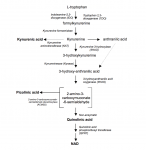nerd
Senior Member
- Messages
- 863
Groven N, Reitan SK, Fors EA, Guzey IC. Kynurenine metabolites and ratios differ between Chronic Fatigue Syndrome, Fibromyalgia, and healthy controls. Psychoneuroendocrinology. 2021 Sep;131:105287. doi: 10.1016/j.psyneuen.2021.105287. Epub 2021 May 27. PMID: 34090138.
Abstract
Abstract
Background: There is growing evidence that the kynurenine pathway is involved in the pathology of diseases related to the central nervous system (CNS), because of the neuroprotective or neurotoxic properties of certain metabolites, yet the role of each metabolite is not clear. The pathology of Chronic Fatigue Syndrome (CFS) and Fibromyalgia (FM) is currently under investigation, and the overlapping symptoms such as depression suggest that the CNS may be involved. These symptoms may be driven by enhanced neurotoxicity and/or diminished neuroprotection. However, the kynurenine metabolite status has not been well studied in these two possible related disorders of CFS and FM. The objective of this study was to investigate the metabolites and ratios of the kynurenine pathway in CFS and FM compared to healthy controls and examine the possible correlations with symptoms of anxiety and depression.
Method: In this study, females aged 18-60 were included: 49 CFS patients; 57 FM patients; and 54 healthy controls. Blood plasma was analysed for the following metabolites involved in the kynurenine pathway: Tryptophan, kynurenine, kynurenic acid (KA), 3-hydroxykykynurenine (HK), anthranilic acid, xanthurenic acid (XA), 3-hydroxyanthranilic acid, quinolinic acid (QA) and picolinic acid. The concentrations of these metabolites, as well as the ratios of different metabolites indicating enzymatic activity, were compared between the groups. Findings were controlled for age, body mass index (BMI), and symptoms of anxiety and depression.
Results: QA differed between CFS and FM patients (β = .144, p = .036) and was related to higher levels of BMI (β = .017, p = .002). The neuroprotective ratio given by KA/QA was lower for CFS patients compared to healthy controls (β = -.211, p = .016). The neuroprotective ratio given by KA/HK was lower for FM patients compared to healthy controls, and this lower neuroprotective ratio was associated with increased symptoms of pain. The kynurenine aminotransferase II (KAT II) enzymatic activity given by XA/HK was lower for FM patients compared to healthy controls (β = -.236, p = .013). In addition, BMI was negatively associated with enhanced KAT II enzymatic activity (β = -.015, p = .039). Symptoms of anxiety and depression were not associated with the metabolites or ratios studied.
Conclusion: Our study indicates associations between kynurenine metabolism and CFS and FM as well as characteristic symptoms like fatigue and pain. Forthcoming studies indicating a causative effect may place kynurenine metabolites as a target for treatment as well as prevention of these conditions in the future.

